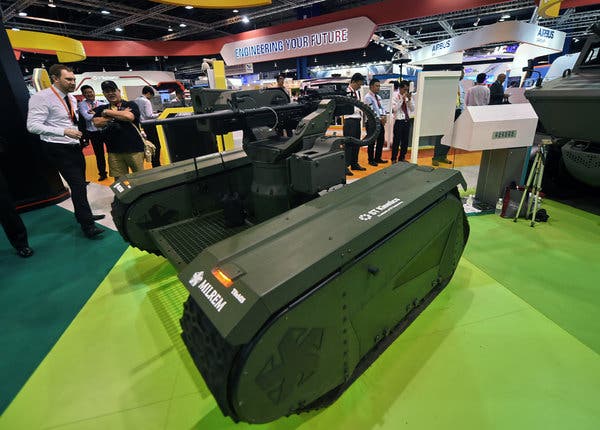As I have told you extensively in the past, armed robots are becoming standard bearers of (hopefully avoidable) future wars. The question is how long they will let humans decide what to do.
An Estonian company has partnered with a Singapore company to develop robotic combat vehicles, specifically a robot tank.
More and more companies are developing UGVs, “unmanned ground vehicles”. Trivially: armed unmanned ground vehicles. There are private businesses and official government programs at play, but it's unclear how quickly militaries will actually be able to deploy significant numbers of tank-like ground robots.
In recent months, news came that the Estonian company Milrem Robotics and Singapore's ST Engineering tested a new UGV during an exercise held in Tapa, Estonia.
According to the Estonian World website, the new UGV is armed with a 40mm automatic grenade launcher and a 12,7mm heavy machine gun.
“Our armored combat UGV is one of the first in the world particularly suited for urban warfare scenarios,” he says Juri Pajuste, director of Milrem Robotics.
Robot tank: the characteristics
The joint warfare system consists of the THeMIS unmanned ground vehicle and the DM ADDER remote station. The vehicle can overcome slopes of up to 60%, and overcome aquatic ditches 60 centimeters deep. Its maximum speed is 20 kilometers per hour, and it is powered by a diesel-electric engine which, depending on the mission, can offer 15 hours of constant operation without refueling.
The combat UGV is configured for wireless control from a distance of 1 to 2,5 kilometers. The difference is in the urban or rural context (therefore more closed or open spaces, where transmissions are easier).
Fight like in a video game
The operator can control the system remotely from a mobile or fixed “ergonomic” station, combined with a graphical user interface for an intuitive workflow and improved execution. The system significantly reduces the cognitive workload on the operator and improves combat performance. Practically an arcade.

The fleet is growing
Milrem's UGV joins the growing field of robot tanks. The British company QinetiQ has deployed inApril 2019 armed vehicles to provide support during a simulated assault by the Royal Marines.
In the US, the Army has begun developing a robotic armored vehicle that could replace some of its older combat vehicles. The first tests have taken place already in the 2017: An armed, robotic M-113 vehicle provided covering fire for soldiers during an exercise in Michigan.
What about Russia? Haste is a bad adviser
Russia more than most countries is in a hurry to deploy armed UGVs, but in a position of strong advantage over laser weapons, has wet dust on this front.
The desire to burn the stages has led to some serious failures. In May 2018 the Russian military deployed a Uran-9 remote-controlled tank to Syria: just a month later, the Kremlin admitted that the UGV was not ready for front-line use.
“Modern Russian unmanned ground vehicles are not capable of performing the tasks assigned in classical combat operations”said the senior research official Andrei Anisimov at a conference at the Kuznetsov Naval Academy in St. Petersburg.
Sensors unable to detect enemies, blunt weapons, unstable movement, delay in executing commands. A total disaster.
Now the Kremlin is upgrading the Uran-9 in an effort to fix some of the UGV's problems. But Anisimov believes it may take up to 15 years before UGVs are ready for “such complex tasks” as ground combat.


